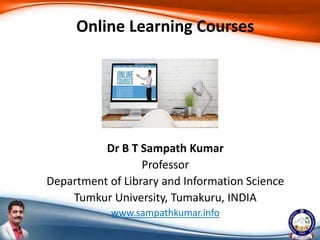
Online learning courses
- 1. Dr B T Sampath Kumar Professor Department of Library and Information Science Tumkur University, Tumakuru, INDIA www.sampathkumar.info Online Learning Courses
- 2. Online learning courses • Use of electronic technologies to access educational curriculum outside of a traditional classroom. • It provides an affordable and flexible way to: – learn new skills – advance your career and – deliver quality educational experiences at scale.
- 3. Need and Importance • To get world-wide exposure by both teachers and learners. • To improve pedagogical techniques and knowledge sharing. • To use it as a tool in a blended learning program, where students can access more information than what is provided in the class.
- 4. Cont.. • To offer various Courses at free of cost. • To access courses offered by professors at the top universities. • To get access to the courses which are available to a vast and diverse audience across the globe.
- 5. What are MOOCs? • MOOC stands for Massive Open Online Course. • Massive because enrolments are unlimited and can run into hundreds of thousands. • Open because anyone can enrol — that is, there is no admission process. • Online because they are delivered via the internet. • Course because their goal is to teach a specific subject.
- 6. Cont.. • MOOCs are courses delivered online and accessible to all for free. • MOOC is a model for delivering learning content online to any person who wants to take a course, with no limit on attendance.
- 7. SWAYAM • Study Webs of Active Learning for Young Aspiring Minds • It is a programme of the Ministry of Human Resource Development, Government of India, • It is designed to achieve the three cardinal principles of Education Policy viz., access, equity and quality.
- 8. Cont.. • It enables professors and faculties of centrally funded institutions: – IITs – IIMs – Central University of Haryana to offer online courses to citizens of India.
- 9. Cont.. • The objective of this effort is to take the best teaching learning resources to all, including the most disadvantaged. • It seeks to bridge the digital divide for students who have hitherto remained untouched by the digital revolution and have not been able to join the mainstream of the knowledge economy.
- 10. Courses
- 11. Quadrants • The courses hosted on SWAYAM are in 4 quadrants – Video lecture – Reading material that can be downloaded/printed – Self-assessment tests through tests and quizzes – An online discussion forum for clearing the doubts.
- 12. National Coordinators • In order to ensure the best quality content is produced and delivered, nine National Coordinators have been appointed. They are: – All India Council for Technical Education (AICTE) for self-paced and international courses. – National Programme on Technology Enhanced Learning (NPTEL) for Engineering.
- 13. Cont.. – University Grants Commission (UGC) for non technical post-graduation education. – Consortium for Educational Communication (CEC) for under-graduate education.
- 14. Cont.. – National Council of Educational Research and Training (NCERT) for school education. – National Institute of Open Schooling (NIOS) for school education. – Indira Gandhi National Open University (IGNOU) for out-of-school students.
- 15. Cont.. – Indian Institute of Management, Bangalore (IIMB ) for management studies. – National Institute of Technical Teachers Training and Research (NITTTR) for Teacher Training programme.